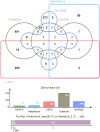Identification of genetic susceptibility in preterm newborns with bronchopulmonary dysplasia by whole-exome sequencing: BIVM gene may play a role
- PMID: 36757497
- PMCID: PMC10167099
- DOI: 10.1007/s00431-022-04779-z
Identification of genetic susceptibility in preterm newborns with bronchopulmonary dysplasia by whole-exome sequencing: BIVM gene may play a role
Abstract
Bronchopulmonary dysplasia (BPD) is a common chronic respiratory disease in preterm infants caused by multifactorial etiology. Genetic factors are involved in the occurrence of BPD, but studies have found that candidate genes have poor reproducibility and are influenced by ethnic heterogeneity; therefore, more exploration is still needed. We performed whole-exon sequencing in 34 preterm infants with BPD and 32 non-BPD control neonates. The data were analyzed and interpreted by Fisher difference comparison, PLINK and eQTL association analysis, KEGG and GO enrichment analysis, STRING tool, Cytoscape software, ProtParam tool, HOPE online software, and GEOR2 analysis on NCBI GEO dataset. BPD has a highly heterogeneity in different populations, and we found 35 genes overlapped with previous whole-exon sequencing studies, such as APOB gene. Arterial and epithelial cell development and energy metabolism pathways affect BPD. In this study, 24 key genes were identified, and BIVM rs3825519 mutation leads to prolonged assisted ventilation in patients with BPD. A novel DDAH1 mutation site (NM_012137: exon1: c.89 T > G: p.L30R) was found in 9 BPD patients.
Conclusion: BIVM gene rs3825519 mutation may play a role in the pathogenesis of BPD by affecting cilia movement, and the DDAH1 and APOB genes mutations may have a pathogenic role in BPD.
What is known: • Genetic factors are involved in the occurrence of bronchopulmonary dysplasia. • The candidate genes have poor reproducibility and are influenced by ethnic heterogeneity, therefore, more exploration is still needed.
What is new: • We identified the role of susceptible SNPs in BPD in Shenzhen, China, and identified 24 key genes that influence the pathogenesis of BPD, and also found 35 genes overlapped with previous whole exon sequencing studies, such as APOB gene. • We found that BIVM and DDAH1 genes may play a pathogenic role in the pathogenesis of BPD.
Keywords: BIVM gene; Bronchopulmonary dysplasia; Genetic susceptibility; Single-nucleotide polymorphisms; Whole-exome sequencing.
© 2023. The Author(s).
Conflict of interest statement
The authors declare no competing interests.
Figures







Similar articles
-
Exome sequencing and pathway analysis for identification of genetic variability relevant for bronchopulmonary dysplasia (BPD) in preterm newborns: A pilot study.Clin Chim Acta. 2015 Dec 7;451(Pt A):39-45. doi: 10.1016/j.cca.2015.01.001. Epub 2015 Jan 8. Clin Chim Acta. 2015. PMID: 25578394
-
Exome Sequencing of Neonatal Blood Spots and the Identification of Genes Implicated in Bronchopulmonary Dysplasia.Am J Respir Crit Care Med. 2015 Sep 1;192(5):589-96. doi: 10.1164/rccm.201501-0168OC. Am J Respir Crit Care Med. 2015. PMID: 26030808 Free PMC article.
-
Polymorphisms of fibronectin-1 (rs3796123; rs1968510; rs10202709; rs6725958; and rs35343655) are not associated with bronchopulmonary dysplasia in preterm infants.Mol Cell Biochem. 2022 Jun;477(6):1645-1652. doi: 10.1007/s11010-022-04397-1. Epub 2022 Mar 1. Mol Cell Biochem. 2022. PMID: 35230604
-
The genetic predisposition to bronchopulmonary dysplasia.Curr Opin Pediatr. 2016 Jun;28(3):318-23. doi: 10.1097/MOP.0000000000000344. Curr Opin Pediatr. 2016. PMID: 26963946 Free PMC article. Review.
-
Inhalation or instillation of steroids for the prevention of bronchopulmonary dysplasia.Neonatology. 2015;107(4):358-9. doi: 10.1159/000381132. Epub 2015 Jun 5. Neonatology. 2015. PMID: 26044104 Review.
Cited by
-
Phenotype wide association study links bronchopulmonary dysplasia with eosinophilia in children.Sci Rep. 2024 Sep 13;14(1):21391. doi: 10.1038/s41598-024-72348-5. Sci Rep. 2024. PMID: 39271728 Free PMC article.
-
[Management of lung diseases under ultrasound monitoring: potential to make bronchopulmonary dysplasia in preterm infants as an avoidable disease].Zhongguo Dang Dai Er Ke Za Zhi. 2024 Jan 15;26(1):14-18. doi: 10.7499/j.issn.1008-8830.2309120. Zhongguo Dang Dai Er Ke Za Zhi. 2024. PMID: 38269453 Free PMC article. Chinese.
-
Knockdown of the long noncoding RNA VSIG2-1:1 promotes the angiogenic ability of human pulmonary microvascular endothelial cells by activating the VEGF/PI3K/AKT pathway.Respir Res. 2024 Nov 20;25(1):412. doi: 10.1186/s12931-024-03039-y. Respir Res. 2024. PMID: 39568008 Free PMC article.
-
Clinical analysis and predictive value of early serum lipid levels in very premature and extremely preterm infants with bronchopulmonary dysplasia: a 4 years retrospective study.BMC Pediatr. 2025 Feb 17;25(1):119. doi: 10.1186/s12887-025-05474-2. BMC Pediatr. 2025. PMID: 39962399 Free PMC article.
References
-
- Bell EF, Hintz SR, Hansen NI, Bann CM, Wyckoff MH, DeMauro SB, Walsh MC, Vohr BR, Stoll BJ, Carlo WA, et al. Mortality, in-hospital morbidity, care practices, and 2-year outcomes for extremely preterm infants in the US, 2013–2018. JAMA. 2022;327:248–263. doi: 10.1001/jama.2021.23580. - DOI - PMC - PubMed
-
- Jiangsu Multicenter Study Collaborative Group for Breastmilk Feeding in Neonatal Intensive Care Units (2019). Clinical characteristics and risk factors of very low birth weight and extremely low birth weight infants with bronchopulmonary dysplasia: multicenter retrospective analysis [J]. Chin J Pediatr 57(01): 33–9. 10.3760/cma.j.issn.0578-1310.2019.01.009 - PubMed
-
- Bronchopulmonary dysplasia of preterm infants Collaborative Group (2011). Incidence and risk factors of bronchopulmonary dysplasia in premature infants in 10 hospitals in China [J]. Chin J Pediatr (09): 655–62. - PubMed
MeSH terms
Substances
Grants and funding
LinkOut - more resources
Full Text Sources
Medical
Molecular Biology Databases
Miscellaneous

